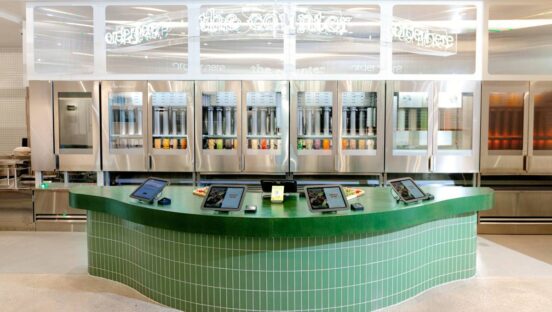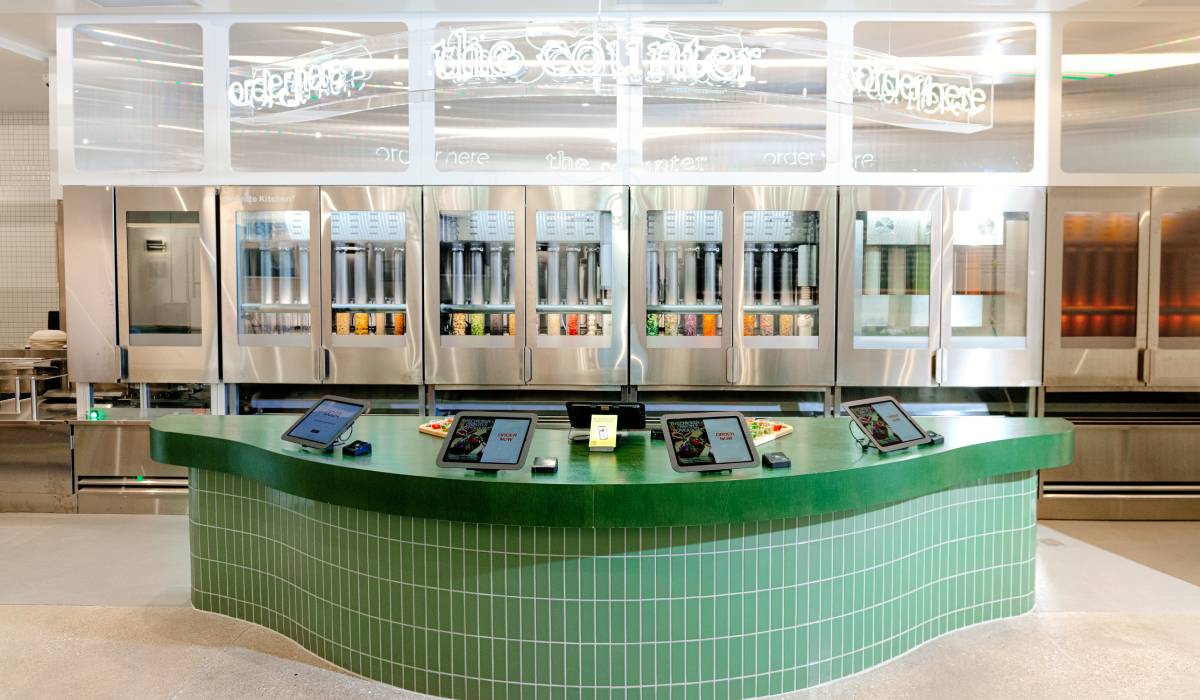Sweetgreen wrapped up 2023 in better shape than it started, and although it hasn’t reached profitability yet, CEO Jonathan Neman is confident it can achieve that goal this year.
He’s especially optimistic about the potential of the Infinite Kitchen, an assembly line engine that dispenses ingredients along a conveyor belt. Two stores with the salad-making robot came online last year, one outside of Chicago in Naperville, Illinois, and another in Huntington Beach, California. Neman said the biggest benefit so far has been on the labor front since half of the chain’s variable labor in restaurants is related to production or assembly. The technology is cutting down on staffing requirements and freeing up employees to focus on customer-facing tasks, resulting in “substantially lower” team member turnover.
The next batch of automated restaurants could deliver even more benefits when it comes to boosting throughput and driving revenue. The Infinite Kitchen is capable of producing up to 500 bowls, plates, and sides per hour—50 percent more than a typical restaurant’s front and digital makeline combined—but Naperville and Huntington Beach are suburban markets, where demand isn’t high enough to demonstrate that capacity.
“We intentionally tested it there because we wanted to make sure that it would work not just in higher volume, high throughput locations, but really all over the country,” Neman told investors during the company’s Q4 earnings call last week. “We have to have a lot of confidence that it will work in suburban neighborhoods.”
Consider that box checked. Neman said the Infinite Kitchen is delivering significant benefits to the operating model, even if it isn’t reaching its full throughput potential in those first two stores.
The average check at both locations is 10 percent higher than other units in their respective markets. They’re also seeing a roughly 7 percent margin improvement, thanks to improved portioning and better order accuracy.
READ MORE:
Sweetgreen Goes All-In with Automated Restaurants
Sweetgreen’s Infinite Kitchen Widens Path to Profitability
Sweetgreen CEO: All Stores will be Automated in Five Years
Now, Sweetgreen wants to see what the Infinite Kitchen can do in other environments. Seven new builds will feature the technology this year. The company also plans to renovate three to four existing stores with the automated makeline.
“Some of the stores we’re retrofitting will be stores with very high demand, so we’re excited to see what that does, especially in some of the urban environments where we are capacity constrained,” Neman said. “We do expect a sales lift in those restaurants … We’ve been able to learn a lot about customer experience, savings on labor, savings on getting things more accurate, lower turnover costs, less hiring because the teams are just smaller, but the throughput and the greater capture of revenue is something that we’ll be able to talk a lot more about later this year.”
The seven additional automated restaurants are among the 23-27 new units slated for 2024. That’s down from the 35 new stores Sweetgreen netted last year, which pushed its total footprint to 221 locations. The reason for the slowdown is to better integrate the technology into the pipeline. The company expects to ramp up development next year and have a greater share of Infinite Kitchens in 2025’s class of new builds.
Sweetgreen also is finding opportunities to improve execution in traditional stores. It eliminated some labor-intensive tasks to streamline workflows. It also introduced tipping, tightened labor deployment, and adjusted head coach scheduling to give store-level leaders more time on the floor.
Whether it’s with the Infinite Kitchen or in non-automated stores, labor adjustments and efforts to maximize throughput are pushing Sweetgreen further along the path to profitability. The company’s net loss narrowed to $27.4 million in Q4, compared to a loss of $49.3 million in the same period a year ago. Revenues grew 20 percent to $153 million. Comps were up 6 percent, consisting of a 5 percent benefit from menu prices and a 1 percent benefit from traffic and mix. Restaurant-level profit margin was improved more than 500 basis points year-over-year to 16.2 percent.
On a full-year basis, Sweetgreen’s net loss decreased to $113.4 million from $190.4 million, with revenues up 24 percent and comps up 4 percent. Restaurant-level profit margin for fiscal 2023 was 17.5 percent.
Neman said that even without the Infinite Kitchen, Sweetgreen has a clear path to 20 percent store-level margins with its traditional operating model. Labor adjustments and operational improvements will continue to play a big role in that story.
The company also is increasing its marketing spend and leaning into menu innovation to expand its customer reach and grow transactions. To that end, it set out on its biggest menu launch in several years when it debuted a new line of Protein Plates in Q4. With offerings including Miso Glazed Salmon, Southwest Chicken Fajita, and Hot Honey Chicken, the platform is geared toward growing the chain’s share at dinner. Neman said the plates are exceeding internal expectations and boosting sales during the evening daypart. Another new protein, Caramelized Garlic Steak, is undergoing testing and could roll out nationally later this year.
Loyalty is the other key lever for driving revenue, though Neman admitted Sweetpass, a two-tiered loyalty program that debuted this spring, hasn’t moved the needle much. The program features a free component and a paid component called Sweetpass Plus, where guests receive $3 off daily Sweetgreen orders, priority customer support, delivery perks, premier access to merch drops, and other exclusive experiences for $10 a month. He told investors the company is seeing “some nice incrementality” out of the Sweetpass Plus program, “but it’s not a huge membership base, so it’s not really driving the overall transaction growth in a big way.”
He sees plenty of opportunities for improvements that could make the core rewards program a bigger transaction and customer acquisition driver, including simpler rewards, a better in-app experience, and more one-to-one personalization.
“I think there’s a lot we can do around CRM and campaigns to drive that incremental visit, so look for some pretty significant changes and optimizations coming,” Neman said. “The good news is we built the technology. The tech stack is there, and we’re able to use the foundation in order to improve this program to work for us.”
Looking ahead, Sweetgreen is projecting full-year revenue ranging between $655 million and $670 million, same-store sales growth between 3-5 percent, restaurant-level margins of 18-19.5 percent, and adjusted EBITDA between $8 million and $15 million.








